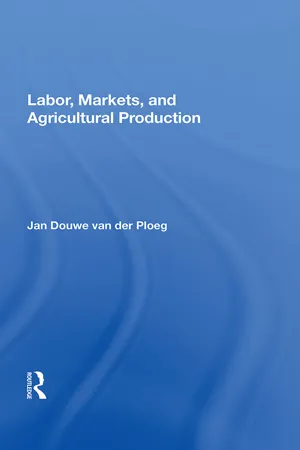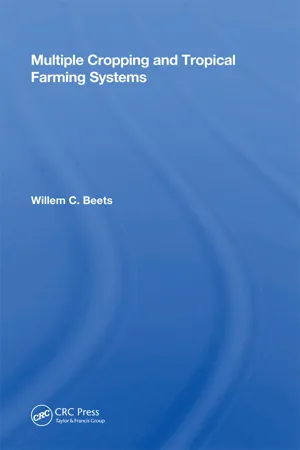Geography
Extensive Farming
Extensive farming is a type of agricultural practice that involves large-scale cultivation of vast areas of land with minimal inputs and low labor requirements. It typically focuses on producing a few staple crops or livestock and is characterized by low intensity and high land use. This method is often used in areas with abundant land and relatively low population density.
Written by Perlego with AI-assistance
5 Key excerpts on "Extensive Farming"
Learn about this page
Index pages curate the most relevant extracts from our library of academic textbooks. They’ve been created using an in-house natural language model (NLM), each adding context and meaning to key research topics.
- eBook - ePub
- Jan Douwe van der Ploeg(Author)
- 2019(Publication Date)
- CRC Press(Publisher)
Until the 1950s, diversity between, and especially within, agricultural areas was classified and understood in terms of intensive and extensive styles of agriculture practice. Thus the concept of “intensification” meant the ongoing development of intensive styles of farming; it referred to the progressive raising of intensity levels. The term “extensification” referred to the opposite tendency.But these terms were anything but neutral. Intensive agriculture stood for better agriculture. It was not only desirable; it equaled progress. “Good farming,” wrote Graham Brade-Birks (1950:XVI), “means farming so carried out as to produce the maximum economic output from the land.” He described this “good farming” as “intensive farming,” directed to “those practices designed to produce a very high output.” Technical efficiency and economic results followed logically from each other. In contrast, Extensive Farming, “the practice of using the minimum amounts of labor, cultivation and manure,” was referred to as “a low standard of farming.” An authoritative Dutch author of the time, Minderhoud, wrote “intensification is rooted in the rule of raising the net yield, while extensification lies in saving labor and capital: thus one has to take a reduction of yield in kind for love” (1948:45).Also interesting, in retrospect, is the debate which was then taking place over the farm economy ratio behind both processes of development. Minderhoud criticized those who “calculate at which intensity total production costs per kg are the lowest and give the impression that the farmer must strive for that.” Contained in this whole issue is the question of which of the concepts corresponds most accurately to actual relations in agriculture and can thus be used as normative, as goals at the enterprise level. In short, what we now know as an established theory, namely, neoclassical agricultural economics, was then still subject to fondamental differences of opinion. Thus, according to Minderhoud, the proposition that the farmer must strive for the lowest price per unit of end product, “the problem is incorrectly posed.” Situations vary and thus “the manner in which the soil can be rationally exploited” also varies. His comment that “many American writers, … take the circumstance of sufficient ground, but insufficient labor and capital as a starting point for consideration, with the consequence that West European readers find them difficult to follow,” is a telling one (1948:52). - eBook - ePub
- J. J. Black(Author)
- 2016(Publication Date)
- Addison Press(Publisher)
FarmingAgriculture, also called farming or husbandry, is the cultivation of animals, plants, or fungi for fibre, biofuel, drugs and other products used to sustain and enhance human life. Agriculture was the key development in the rise of sedentary human civilization, whereby farming of domesticated species created food surpluses that nurtured the development of civilization. It is hence, of extraordinary importance for the development of society, as we know it today. The word agriculture is a late Middle English adaptation of Latin agricultūra , from ager , ‘field’, and cultūra , ‘cultivation’ or ‘growing’. The history of agriculture dates back thousands of years, and its development has been driven and defined by vastly different climates, cultures, and technologies. However all farming generally relies on techniques to expand and maintain the lands that are suitable for raising domesticated species. For plants, this usually requires some form of irrigation, although there are methods of dryland farming. Livestock are raised in a combination of grassland-based and landless systems, in an industry that covers almost one-third of the world’s ice- and water-free area.Agricultural practices such as irrigation, crop rotation, fertilizers, pesticides and the domestication of livestock were developed long ago, but have made great progress in the past century. The history of agriculture has played a major role in human history, as agricultural progress has been a crucial factor in worldwide socioeconomic change. Division of labour in agricultural societies made (now) commonplace specializations, rarely seen in hunter-gatherer cultures, which allowed the growth of towns and cities, and the complex societies we call civilizations. When farmers became capable of producing food beyond the needs of their own families, others in their society were freed to devote themselves to projects other than food acquisition. Historians and anthropologists have long argued that the development of agriculture made civilization possible. - eBook - ePub
Population, Agriculture, and Biodiversity
Problems and Prospects
- J. Perry Gustafson, Peter H. Raven, Paul R. Ehrlich(Authors)
- 2020(Publication Date)
- University of Missouri(Publisher)
Many experts, however, believe that food will be at a shortage in the future and support a strategy of “sustainable intensification” based on principles of agro-ecology (Garnett et al., 2013; Godfray and Garnet, 2014; Pretty and Bharucha, 2014). This strategy is not well defined in most cases and lacks operational details. However, it is supposed to facilitate higher production of vegetative food while minimizing the environmental impact of the agricultural practice and withstanding the expected global climatic changes. This seems to be a tremendous challenge to pursue.The scientific literature contains many attempts to define the agro-ecology discipline; therefore, we follow Francis et al. (2003, p. 100) who see agro-ecology as “the integrative study of the ecology of the entire food system, encompassing ecological, economic and social dimensions.” Agro-ecology attempts to modify all facets of the agricultural practice into a more environmentally friendly activity without losing productivity.Fertile soil is an essential condition for successful cropping everywhere. Even though this is known to most farmers, in the U.S., for example, almost 20 percent of their farmlands have been degraded and lost productivity to some extent since 1945 as an outcome of human mismanagement (Tilman et al., 2002). All over the world cultivable soils have been degraded and depleted due to erosion, compaction, loss of organic matter and nutrients, and contamination by pesticides and heavy metals (Lal, 1990; Pimentel, 2006).One of the pillars of agro-ecology is “conservation agriculture,” which aims to cope with these destructive processes. Conservation agriculture (CA) is actually a combination of three principal management activities intending to minimize soil disturbance and maximize crop yields over time: no- or shallow-till, application of cover crop or mulch, and a well-orchestrated crop rotation (Hobbs, 2007; Hobbs et al., 2008). A review of more than two hundred studies from all over the world indicated that under conventional tillage soil loss due to erosion is one to two times higher than the rate of new soil creation in natural habitats (Montgomery, 2007). In other words, conventional tillage is not sustainable. On the other hand, the rate of erosion from fields with no ploughing is like the rate of soil production (Montgomery, 2007). - eBook - ePub
- Willem C. Beets(Author)
- 2019(Publication Date)
- CRC Press(Publisher)
The way crops are grown further depends on the level of technology and the land area available. At high levels of technology and land abundance there is generally a high level of mechanization, and uniformity of land, soil fertility and genotype are needed. On the other hand when land is scarce, cropping systems tend to be more intensive and less mechanized.When the above broad factors are taken into consideration, the main specific determinants of farming systems can be summarized as follows:- (i) land availability and population density;
- (ii) type of crop rotation;
- (iii) water supply;
- (iv) cropping pattern;
- (v) type of implements used for cultivation; and
- (vi) degree of commercialization.
- (i) extensive shifting cultivation;
- (ii) intensive subsistence agriculture; and
- (iii) commercial, frequently mechanized, crop tillage.
Figure 1.1 Global distribution of the three main tropical farming systems. (After Whittlesey, 1974; Wagner and Mikesell, 1965).The distribution of these farming systems is shown in Figure 1.1 . Multiple cropping , defined as growing more than one crop on the same piece of land during one calendar year, takes place in different forms in all three farming systems.For the purpose of this book the following typology of the main multiple cropping systems has been adopted:- (i) Mixed cropping is defined as growing more than one crop on the same piece of land at the same time. It is common in shifting cultivation systems which occur in almost half the tropical world. Intercropping is a form of mixed cropping where all crops are planted in a fixed pattern of spacings and rows.
- (ii) Relay cropping
- eBook - ePub
The Conditions of Agricultural Growth
The Economics of Agrarian Change Under Population Pressure
- Ester Boserup(Author)
- 2014(Publication Date)
- Routledge(Publisher)
Students of economic history have not failed to describe the successive changes within primitive agricultural systems, but this has largely passed unnoticed by economists. They tended to regard the existing methods of cultivation and systems of land use as permanent features of a given locality, reflecting its particular natural conditions, rather than as phases in a process of economic development. In accordance with this view, the causal explanation of differences in cultivation systems was supposed to be a matter for geographers to consider; and these would naturally be inclined to explain differences in agricultural methods in terms of climatic conditions, type of soil and other natural factors which were believed to remain uninfluenced by changes in the size of population. It is in the logic of this approach to expect that major increases of agricultural population within a given area must result in the emergence of a labour surplus on the land and a consequent pressure for migration to other regions or to urban areas.Our investigation in the preceding pages lends no support to this conception of an agrarian surplus population emerging as the result of population growth. We have found that it is unrealistic to regard agricultural cultivation systems as adaptations to different natural conditions, and that cultivation systems can be more plausibly explained as the result of differences in population density: As. long as the population of a given area is very sparse, food can be produced with little input of labour per unit of output and with virtually no capital investment, since a very long fallow period helps to preserve soil fertility. As the density of population in the area increases, the fertility of the soil can no longer be preserved by means of long fallow and it becomes necessary to introduce other systems which require a much larger agricultural labour force. By the gradual change from systems where each cultivated plot is matched by twenty similar plots under fallow to systems where no fallow is necessary, the population within a given area can double several times without having to face either starvation or lack of employment opportunities in agriculture.




